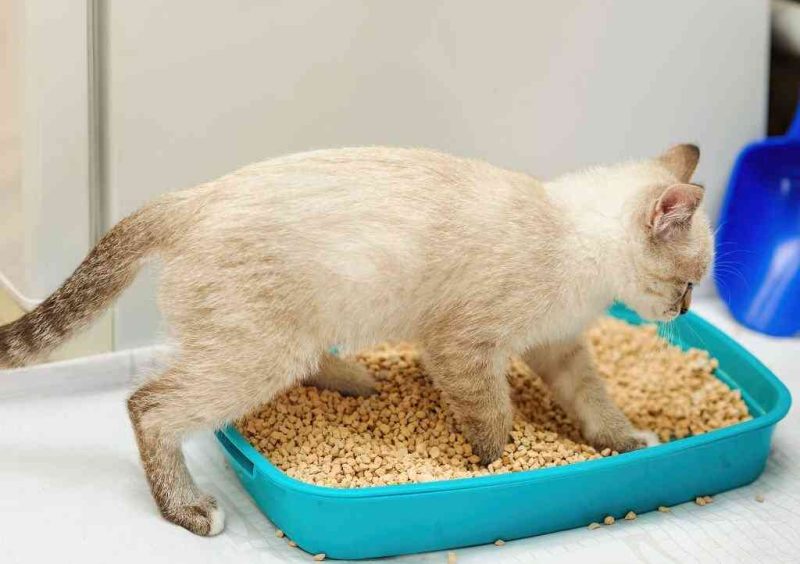Does cat litter expire? Does kitty litter expire? Does cat litter have an expiration date? What happens when cat litter expires? How to tell if your cat litter has expired. These are the questions we are going to cover in this article.
What Is Cat Litter
Cat litter is essential for cat owners as it ensures an odour-free and clean environment for the feline resident and household members.
Various cat litter varieties are available on the market today, with clay-based litter being among the most popular choices. At the same time, silica gel crystals, recycled paper and natural materials like wood or corn absorb moisture while controlling odours. Each variety has its advantages and characteristics, but all work to absorb moisture while controlling odour.
Does Cat Litter Expire?
Regarding expiration, cat litter doesn’t technically “expire” as food or medication does. However, its effectiveness and performance may diminish over time if exposed to moisture or extreme environmental conditions. Moisture exposure can make clumping litters harder to manage when trying to clean out your litter box effectively.
Cat litter doesn’t expire like other products. So it should be stored and used within a reasonable time frame for optimal performance. If it absorbs moisture or has musty odours, it would be wise to dispose of it and replace it with a fresh batch. This will help provide your cat with a healthier litter box environment!
Types of cat litters and their storage periods

Cat litters have different shelf lives(expiration periods) depending on their composition and storage method.
Below are different types of cat litters with longer potential shelf lives being listed first:
- Silica Gel Crystals: Silica gel crystal litters have an extended shelf life if stored correctly and in an environment free from moisture and dust. When stored properly in sealed packaging, these highly absorbent crystals should last an extended period.
- Clay-Based Clumping Litters: Clumping litters constructed with natural clay can have an extended shelf life when properly stored and sealed; many such litters remain effective even months later!
- Recycled Paper Litters: Litters made from recycled paper are generally relatively stable and can have an average shelf life. Proper storage away from moisture or humidity may extend their effectiveness and help prolong their effectiveness.
- Pine, Cedar or Wood-Based Litters: Litters made from natural wood materials such as pine needles or cedar have a moderate shelf life when stored properly and sealed tight.
- Corn, Wheat or Plant-based Litters: Litters made of plant materials can be biodegradable but have shorter shelf life than other options. They can quickly degrade if exposed to moisture or high humidity conditions, potentially becoming unsafe.
Though some cat litter may last longer than others, all litter must be stored in a cool, dry location per manufacturer recommendations to ensure optimal performance over time. Suppose any significant changes appear in its appearance or effectiveness over time. In that case, purchasing new supplies and beginning again is best.
How to properly store my cat litter
Storing cat litter correctly is essential to maintaining its quality and effectiveness; here are some guidelines for doing so:
- Store it in a cool and dry area: Moisture can quickly degrade some types of cat litter, decreasing their effectiveness. Ideally, store your litter in a location free from direct sunlight and humidity, such as your garage, utility room or closet for storage purposes.
- Keep Your Bag/Container Tight: Close your cat litter bag or container tightly following each use to keep air and moisture out and maintain freshness without clumping. Doing this will help extend its shelf life as well.
- Avoid Storing Near Chemicals or Strong Odors: Cat litter can absorb any odours present, so keep it away from chemicals, cleaning agents or products with strong fragrances which could transfer their scent onto its contents.
- Do not mix various types of litter: When housing multiple cats or using different varieties, store each type separately to avoid altering its properties and potentially decreasing effectiveness. Mixing can affect each litter’s properties and reduce effectiveness over time.
- Select and Use Oldest Litter First: If you own multiple bags of cat litter, always choose and use the oldest bag first to prevent any leftover litter from sitting around and possibly losing its quality.
- Check for Expiration Dates: While cat litter doesn’t technically expire, it is still wise to review any manufacturer-provided guidelines on its packaging for optimal performance. If a “Best Before” or expiration date is specified on it, aim to use it before this deadline is reached for optimal performance.
- Keep it out of reach from pets and children: Store cat litter in a location inaccessible to their safety and that of your cats and children. Ingesting some types may be harmful and should be prevented at all costs.
By adhering to these storage practices, you can extend the shelf life of cat litter while maintaining its effectiveness in absorbing moisture and controlling odours – creating a safe, comfortable environment for your feline companion.
How do i know when to change my cat litter

It’s essential to the health and happiness of your cat that you know when and how often to change their litter box for both their comfort and the sake of cleanliness in their environment. Here are some telltale signs it may be time to change:
- Odor: One of the telltale signs that it’s time for change is an overwhelming and persistent litter box odour. While some amount of smell may be expected, if it becomes overbearing or remains after scooping, it may signal that change needs to come soon.
- Appearance: Regularly inspect your litter to evaluate its appearance. If clumps, moisture accumulation or faeces deposits appear on its surface, it could indicate that the litter needs to be changed.
- Reduced Absorbency: If your litter seems less effective at absorbing moisture and clumping together, it may have reached its saturation point and should be replaced soon.
- Discomfort or Avoidance: Cats are sensitive to cleanliness, so if their litter box becomes overly filthy, they may avoid using it altogether or experience discomfort.
- Excessive Tracking: If your litter box seems to be tracking out too much litter, it could indicate that its composition has changed or become dusty over time and needs replacing.
- Frequency of Scooping: Depending on the type of litter and the number of cats in your home, daily or more frequent scooping may be required to maintain the cleanliness of the litterbox. Suppose you find that continuous scooping has yet to result in better conditions for cleanliness. In that case, it’s time for an extensive litter change!
- Recommended Duration: Some cat litter brands guide how often to change out an entire litter box. Having this information handy can serve as an invaluable guideline.
As a best practice, it is a good idea to regularly scoop your litter box, remove solid waste and smooth out its surface to maintain cleanliness. Furthermore, changing out all the litter every 1-3 weeks, depending on your cat’s habits and the type of litter used, will keep them happy and encourage consistent use of their box.
What to do if your cat’s litter needs changing

How to change my cat’s litter
If it’s time for a change, here’s what you should do to ensure a smooth and hygienic transition:
- Gather Supplies: Before changing the litter, gather all necessary supplies, including a new bag of cat litter, scooper and trash bags for disposing of old litter.
- Prepare the Litter Box: When emptying out old litter into a garbage bag for disposal, bring the litter box outside or to a sink or bathtub to be thoroughly cleaned with mild soap and water; be sure to use gloves when washing the box to avoid scratching delicate surfaces like enamel surfaces with harsh chemicals like bleach. Rinse thoroughly afterwards to allow it to dry before adding new litter.
- Add New Litter: Once your litter box is clean and dry, open a fresh bag of cat litter and pour enough into it – two to three inches should provide ideal absorption rates.
- Choose the Right Litter: Make sure you choose a litter suitable for your cat, meeting their preferences and needs. Cats can be sensitive to change; staying with the same type of litter for as long as possible or gradually switching can help avoid litter box aversion.
- Dispose of Old Litter Correctly: If you use clumping litter, beware not to flush it down the toilet, as this can create plumbing issues. Instead, place the old litter into a sealed garbage bag before disposing it as regular trash.
- Locate the Litter Box Appropriately: Cats prefer quiet and private locations for their litter box, so ensure it is located away from food and water bowls for optimal use.
- Monitor Your Cat’s Behavior: Observe their reaction and behaviour once you change their litter. Some cats may adjust quickly, while others might take time to adjust. If your cat seems wary or avoids their litter box altogether, be patient and allow them the opportunity to adapt over time.
- Conduct Regular Cleanings: To keep the litter box odour-free and comfortable for your cat, ensure regular scooping of solid waste and that litter boxes are replaced or cleaned every 1-3 weeks to guarantee freshness and hygiene.
Follow these steps to change your cat’s litter box and give them a fresh, clean environment for their toilet space.
Does cat litter expire: Summary

Cat litter is used in litter boxes to absorb and contain cat urine and waste, providing a clean and odour-free environment for cats and their owners. Cat litter comes in various forms, such as clay-based, silica gel crystals, recycled paper and natural materials like wood, corn or wheat. While cat litter does not technically expire over time, its effectiveness can decrease when exposed to moisture or extreme conditions.
Proper cat litter storage in a cool, dry location can significantly extend its shelf life. Some telltale signs that indicate it needs changing include strong odour, decreased absorbency. Moisture build-up or clumps forming on top, discomfort from cats avoiding it altogether or excessive tracking by them.
When switching up litters, ensure a seamless transition by thoroughly cleaning and replenishing the litter box, adding fresh litter, and monitoring your cat’s behaviour closely to ensure an easy changeover. Regular litter box maintenance helps create an environment conducive to good hygiene. In particular, silica gel crystals and clay-based clumping litters tend to last the longest when stored properly.


